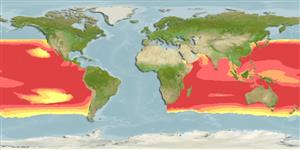Common names from other countries
Environment: milieu / climate zone / depth range / distribution range
экология
морской; мигрирует в океане (Ref. 51243); пределы глубины 0 - 1830 m (Ref. 86942), usually 0 - 350 m (Ref. 89423). Subtropical; 43°N - 56°S, 20°E - 68°W
Indian and Pacific: tropical and temperate waters. Although some stray individuals are found in the Atlantic Ocean, this species is believed to have its spawning grounds and principal populations only in the Pacific and Indian Oceans. Highly migratory species.
Size / Вес / Возраст
Maturity: Lm ? range ? - ? cm
Max length : 230 cm TL самец/пол неопределен; (Ref. 9308); common length : 190 cm TL самец/пол неопределен; (Ref. 9308); наибольший вес (опубликованные данные): 52.0 kg (Ref. 43)
колючие лучи спинного плавника (общее число) : 0; членистые (мягкие) лучи спинного плавника (общее число) : 51 - 57; колючие лучи анального плавника: 0; членистые (мягкие) лучи анального плавника: 18 - 23. Dark blue above, blue splattered with brown on the sides, silvery white below; 1st dorsal fin plain dark blue, other fins brown or dark brown; anal fin bases with tinges of silvery white.
Oceanic and epipelagic, found above the thermocline (Ref. 9308). Feeds on fishes, cephalopods and crustaceans. Also caught as a by-catch of long lines with hooks intended for tuna. Marketed frozen and prepared as fish cakes and sashimi in Japan (Ref. 9308). Also prepared as sausages.
Life cycle and mating behavior
Maturities | размножение | Spawnings | Egg(s) | Fecundities | личинки
Spawning is believed to occur mainly during the winter months, especially in warm offshore currents with surface temperature of about 25°C.
Nakamura, I., 1985. FAO species catalogue. Vol. 5. Billfishes of the world. An annotated and illustrated catalogue of marlins, sailfishes, spearfishes and swordfishes known to date. FAO Fish. Synop. 125(5):65p. Rome: FAO. (Ref. 43)
Статус Красного Списка МСОП (Ref. 130435)
CITES (Ref. 128078)
Not Evaluated
Угроза для людей
Harmless
Использование человеком
рыболовство: не имеет хозяйственного значения; объект спортивного рыболовства: да
дополнительная информация
инструменты
Специальные отчеты
Скачать в формате XML
ресурсы в Интернет
Estimates based on models
Preferred temperature (Ref.
115969): 13.9 - 28.8, mean 26.2 (based on 5116 cells).
Phylogenetic diversity index (Ref.
82804): PD
50 = 0.5630 [Uniqueness, from 0.5 = low to 2.0 = high].
Bayesian length-weight: a=0.00457 (0.00227 - 0.00920), b=3.21 (3.03 - 3.39), in cm Total Length, based on LWR estimates for this species & (Sub)family-body (Ref.
93245).
Trophic level (Ref.
69278): 4.5 ±0.76 se; based on food items.
устойчивость к внешним воздействиям (Ref.
120179): средний (среднего размера), минимальное время удвоения популяции 1.4-4.4 года (Assuming tm=2-4).
Fishing Vulnerability (Ref.
59153): Very high vulnerability (90 of 100).
Climate Vulnerability (Ref.
125649): Moderate vulnerability (45 of 100).
